Students of ethnography are often encouraged to develop an ethnographic sensibility, or an attunement to the material and social relations and practices that produce meaning in the social world. Absent long stretches of supervised fieldwork, how can we teach students to develop this sensibility? The resources available to instructors of qualitative methods are not well suited for this task since they tend to reduce ethnography to a set of tools and procedures or emphasize the importance of an ethnographic sensibility without detailing how it might be acquired.
Over the past several years, Jamie McPike and I have taught ethnography to students in various academic and non-academic settings. We’ve taught traditional undergraduate students, graduate students in sociology and professional programs, as well as working professionals in government and the private sector. Across these teaching and learning environments we’ve successfully used comics (fiction and nonfiction graphic novels and ethnography in graphic form) as a tool to develop students’ ethnographic sensibility.
One way we use comics is by assigning comics and asking students to “decode” them (comics-speak for the act of engaging the multimodality of graphic texts). We’ve found that decoding engages a set of skills and sensibilities akin to those needed for ethnography. Decoding comics requires practicing slow and sustained ‘reading’ of written language and visual communication and encourages students to appreciate how meaning emerges from the juxtaposition of communicative forms, much like ethnographers in the field might. Likewise, decoding comics requires attention to the detail found in each frame while taking in the page as a whole. The zooming in and out from detail to context and, indeed, structure that decoding requires is a skill ethnographers prize.
This is not all, as students build decoding skills and sensibilities, comics invite questions about authorship and the politics of representation. In our experience, classroom discussions about comics often turn to choices authors and illustrators make or to questions about what the conventional structure of frames and “gutters” (the space between frames) afford authors. One exercise we encourage is having students think through other ways the story might have been told.
There are many wonderful and quite sociological comics to choose from, including ethnographies published as comics. In our classes we’ve used titles as varied as Joe Sacco’s (2003) journalistic comic The Fixer: A Story from Sarajevo which tell stories of the Bosnian war, to Mariko Tamaki and Jillian Tamaki’s (2014) This One Summer, a fictional coming of age story. Books that really helped Jamie and I understand comics and appreciate how to use them in our classes include Scott McCloud’s (1993) classic Understanding Comics: The Invisible Art, much of Linda Barry’s work and the magnificent Unflattening by Nick Sousanis.
While the initial impetus for using comics in ethnography classes came from the specific challenges of teaching students certain skills , over the years I’ve seen how including comics in sociology classes has other benefits. If teaching is public sociology and students are our first public, then we must find ways to engage them by bringing sociological concepts and tools closer to them. Comics can help.


Comments